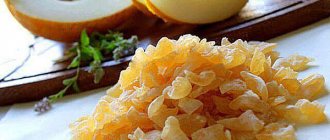A melon crop whose homeland is considered to be Central Asia. The first mentions of it can be found in the Bible. This is a very heat-loving plant that can have 2–8 fruits depending on the variety, conditions and place of growth. The storage conditions for melon are almost the same as for watermelon: in order for the fruits to last longer, they are removed from the melon plant slightly unripe, having a hard surface without dents or damage. Let's take a closer look at the question of how to store melon at home.
Shelf life of melon by variety
Whether the fruits will keep well depends on how dense their pulp is. It is also important how much pectin they contain. This figure should not be less than 4%. Early or “summer” varieties are not stored at all. Therefore, they are consumed immediately after they are removed from the melon plant. And varieties that have a long growing season must lie down for several months after harvest until fully ripened.
- Fruits of late varieties can be stored for up to six months.
- Early – up to 1 month.
- Mid-season melons are stored for 3–4 months.
These data are given for those cases where melon is stored in a cellar or places with similar conditions. Any variety can be kept on the refrigerator shelf for no more than a month.
General information
In addition to the existing varieties for long-term storage, a variety of smooth yellow melon has been developed in the middle zone; its weight usually does not exceed 4 kg. Melon of the Yellow Canary variety can last longer than 1 month. It is characterized by early ripening, excellent taste and shelf life even at home, for example, near a balcony door. The late-ripening varieties Zimovka and Bykovchanka are unlikely to ripen in our middle zone, but in the southern regions they will last for about 6 months. They are characterized by a strong crust and high pectin content.
There are indicators for the shelf life of melons from the moment they are collected from melons:
low-life - less than 2 weeks;
short-lived - up to 1 month;
medium-duty – up to 2 months;
bedded - up to 3 months;
very lightweight - more than three months.
Any melon should not be kept on the refrigerator shelf for more than a month. Before doing this, it is better to wrap it in paper or cotton cloth.
How long can melon be stored in the cellar? With regular monitoring up to 3-4 months.
If you are interested in storing fresh melon for a long time, for example, until the New Year, you must fulfill several conditions when choosing a specimen at the market or in a store:
- The mesh on the melon skin should not be either too bright or too dark, and occupy more than half of the entire area.
- The surface must be absolutely free of damage, both visible peel defects (cracks, scratches, brown spots), and dents and seals that can be detected by touch. The stalk should not be completely torn out. Any damaged area will be a source of concentration of microbes and will lead to further decay
- A strong melon smell indicates a ripeness stage suitable for long-term storage.
- Choose a fruit with an elastic nose; in overripe melons it becomes soft.
How to choose fruits for storage
When choosing a melon, there are a few things you should pay attention to. For example, the mesh located on the peel of the fruit should not be too bright or dark in color and occupy more than half of the total area. It can be used to determine the quality of the product and its degree of maturation.
If the melon has a pronounced aroma, this indicates that it has already reached the stage of ripeness that is needed for long-term storage.
The fetal nose should be elastic. It becomes soft only in overripe fruits, which cannot be stored for a long time.
The melon should not be damaged. If its stalk has been completely torn out, or the peel has burst in some places, it will not be suitable for storage. Such a fruit will quickly begin to rot, and it must be consumed first. Fruits that have dents and brown spots rot even faster.
When growing melon with your own hands, it is removed from the melon plant a week before it is completely ripe. The stalk is left at least 3 cm. In this case, it is better to pick the fruit rather than cut it.
Selection criteria when purchasing for long-term storage
How to store a properly selected melon at home largely depends on the initial condition of the fruit. It happens that when creating ideal placement conditions and purchasing a variety suitable for long-term storage, the product still begins to deteriorate after a couple of weeks.
When buying melon for long-term storage, pay attention to the following signs:
- Variety The varieties with late ripening and thick skin are least susceptible to putrefactive processes. Gulyabi and Torpedo have the longest shelf life.
- Degree of maturity. A fully ripe specimen will not last long. It contains a peak concentration of juices, which activate fermentation and spoilage. For long-term storage, it is better to take slightly unripe yellow pumpkin. However, it should have a melon aroma. Otherwise, it will remain tasteless and oxidize before it has time to ripen.
- Appearance of the peel. There should be no soft areas or signs of spoilage on the crust. Overripe pulp, burst rind and cracks are a favorable environment for bacteria to penetrate inside.
- The brightness of the mesh on the peel. An overly pronounced pattern on the crust is a sign of maturity. Such a harvest will not last long. Barely noticeable lines indicate that the fruit is green. The best option is a clear grid with slightly blurred boundaries.
Ideally, it is better to buy melon for long-term storage directly from the fields. The fruit is torn from the stem by hand, leaving a 3-centimeter tail. Cutting reduces the likelihood that the crop will be stored for a long time.
Note! Before harvesting for permanent storage, the greenish fruit is kept in the sun for 2-3 days. This allows you to partially get the desired aroma, but maintains the density of the pulp.
Melon storage conditions
The storage of melon, like other melons, will be long-term if certain conditions are created for it.
- The air temperature in the room where the fruits are located should be +2°C to +4°C,
- Humidity should not exceed 85% and be below 60%.
- In addition, constant access of air is needed. Therefore, the fruits are kept in containers with holes in places with good ventilation.
- Melons cannot be stored in conditions of high humidity (more than 85%). This crop does not tolerate dampness and quickly begins to rot.
- If the humidity is very low, the fruits will soon dry out.
If during harvesting or transportation any of the fruits are missing a stalk, the remaining depression is filled with molten wax so that the melon does not begin to deteriorate in this place.
This vegetable absorbs third-party aromas very well. Therefore, you need to store melon separately from vegetables that have a strong smell. Its proximity to potatoes and beets is unacceptable. But the most dangerous thing for her is to be near apples. These fruits produce a volatile substance - ethylene, which increases the speed of ripening. This proximity will significantly reduce the shelf life.
Before storing melon, do not wash it. Washed vegetables store much worse. If there are dried particles of earth on the peel that you couldn’t shake off, it’s better to leave everything as is. When scraping them with a knife, scratches may form, which will significantly shorten the shelf life of the melon.
Details
If you grow a melon yourself on your own plot for long-term storage, pick it (pick it with your hands, don’t cut it!) about 7 days before it is fully ripe. An unripe green melon will not gain ripeness and will quickly rot. Collect on a dry, sunny day. The stalk should remain shorter than 3 cm.
Rules for the best storage of melon
- The air temperature in the room should not exceed the limits of +2°C to +4°C;
- Keep humidity within 60 – 85%, no lower and no higher. The melon does not tolerate dampness and, if it is present, it will immediately begin to rot; in the opposite situation, on the contrary, it will dry out quickly;
- Good ventilation in the room. For storage, use plastic, or preferably wooden, boxes with a large number of holes to ensure constant free flow of air. The fruits are placed vertically in boxes, half covered with sand, grain, moss, straw or sawdust. Another option is to hang the fruits in string bags without harming the skin. At the same time, the force of attraction decreases, which also helps to increase the shelf life of these heavy fruits;
- If it is necessary to transport fruits whose stalk has been torn out, the resulting hole should be filled with molten wax, but they should still be stored separately from the rest and the condition should be constantly monitored;
- The peculiarity of melon is that it absorbs foreign odors well, because of this it must be stored separately from onions, peppers, garlic and similar aromatic fruits. Avoid being near beets or potatoes. But the most dangerous neighbors for melons, oddly enough, are apples. The fact is that they release a volatile substance into the surrounding space - ethylene, and it can increase the rate of melon ripening, which in this case is undesirable.
- Before storing melons for long-term storage, do not wash them under any circumstances. Contact with water significantly reduces the shelf life of fruits. Even dried earth or other particles should be left on the peel. Do not scrape it with a knife under any circumstances; scratches will negate all your efforts to preserve the fruit.
- The fruits are inspected regularly, at least once a week, in order to notice in time if any of them begin to deteriorate.
IMPORTANT:
The darkened flesh of the melon is poisonous!
If you do not have a cellar, remember that storing melon in an apartment, given that the average room temperature is 20°C - 23°C, is not recommended for longer than 1 week, maximum 10 days. The melon should lie in an area where the sun's rays cannot reach it (on the lower shelves of closed cabinets, under the bed, in a closet without windows). It is better to wrap each fruit in thin paper.
IMPORTANT:
Ultraviolet radiation greatly increases the rate of melon ripening; if it lies in sunlight in a room, long-term storage is not recommended.
How to store cut melon
IMPORTANT:
Cut melon is stored only in the refrigerator and no longer than 48 hours!
If the family cannot finish a whole melon in one sitting, the cut fruit should never be left on the table, but rather hidden in the refrigerator. The seeds and the mucous pulp enveloping them are removed. You can store cut melon for no longer than 2 days. The cut area is covered with paper or a cotton napkin. Cellophane film will lead to rapid rotting. The melon will begin to release ethylene; increasing its concentration in a closed polyethylene space will spoil both the melon itself and the products around it.
Long-term storage in the freezer
If the size of the freezer allows, you can try to store the melon in it until next summer. The qualities of the melon, at least the taste, will be perfectly preserved.
The melon must be thoroughly washed, dried, cut into small slices, from which balls are cut out with a special round spoon. They can then be conveniently used to decorate desserts.
First, the balls are rolled out in one layer on a tray so as not to disturb the shape and frozen overnight, and in the morning they are placed in a bag and placed in the freezer for long-term storage.
Drying
The washed, dried melon is cut into thin (about 1 cm thick) slices. They are laid out on a baking sheet in one layer and kept in an oven preheated to 220°C for about 15 minutes. Next, open the door slightly, and then keep the slices for about 6 more hours at a temperature of 85°C. During the drying process, the slices must be constantly turned from side to side to achieve uniform drying.
Then the baking sheet is taken out and when the slices have cooled, they are transferred to paper and allowed to dry for several days in the open air.
Well-dried melon slices are stored in tightly closed jars or linen bags in a dark place.
Storage at room temperature
At room temperature (+20°C -+23°C) melons remain fresh for no more than 7 days. An important condition for preserving this fruit in an apartment is its complete isolation from sunlight. Ultraviolet light can significantly increase the rate of ripening, and make further storage impossible.
Thus, you can store melon in an apartment in a pantry, under the bed, in a closet, but no more than 7 days. For better preservation, you can wrap each fruit in paper.
If you need to extend the shelf life to 2-3 weeks, it is recommended to use a refrigerator.
Useful tips
Experienced melon growers believe that even a novice gardener who can show the necessary amount of attention and patience can figure out the issues of storing melons.
There are a number of folk wisdom that allow you to extend the shelf life of melon for consumption:
- To prevent the melon aroma from leaving the cut fruit, you should eat the fruit at room temperature, trying not to resort to the refrigerator;
- If part of the melon is not eaten, there is no point in delaying storage. The best ways to process the fruit are by drying or freezing the slices. Such variations will be useful to the housewife in cooking;
- The remains of the melon, two days after opening the fruit, begin to release substances that are dangerous to the body. Even if the fruit was in the refrigerator, it would be better to dispose of it;
- Frozen melon pieces can retain their beneficial qualities for six months. To do this, the fruit is cut into small cubes, which are laid out on a plate at a distance from each other and placed in the freezer. When the parts “set”, they are transferred to plastic bags, carefully closed, removing air, and freezing continues;
- Melon jam is the best way to recycle leftovers from a sweet harvest or purchase.
Storing melon in the cellar
If there is a room with suitable conditions, the fruits are hung there in mesh bags made of cotton fabric, trying not to damage the peel. In a suspended state, the force of attraction has the least influence, and storage time is maximized.
Storing melons in boxes must follow certain rules. The fruits must be placed vertically in the container. Fill it halfway or a little more with sand, grain, or sawdust. You can also use forest moss, straw or reeds to fill the space between the fruits.
Once a week, the harvest is inspected, carefully turning each fruit in order to notice in time if any of them begins to deteriorate.
Ways to keep melon fresh
Advice: melons in storage should be periodically inspected; if a spoiled fruit is found, it should be removed from storage and thrown away, since rotten fruit can cause damage to the rest.
If you want to preserve the fruit for a long time and subject to the correct storage technology, you can use several placement methods:
- In grids. These can be simple products for vegetables, woven from dry twigs and bark. Fruits are stored well in cloth bags. You need to hang the melons so that they do not touch each other or other objects.
- In boxes. Containers with sand will help retain moisture; for this, the melons need to be placed in a vertical position; when covered with sand, the stalk should remain in the air. The sand should be clean and dry, and the fruits should not come into contact with each other or with the walls of the boxes. The lid of the box does not close tightly to maintain air circulation in the storage.
- On the shelves. To do this, the shelf is prepared for storage - covered in one layer with sawdust, straw, cloth. Periodically you need to inspect the place where the fruit comes into contact with the surface: there should be no signs of rotting there.
Read more ► How to keep grapes fresh all winter
If there are other fruits or vegetables in the storage room, then you should keep them at a distance from the melon so that the fruit does not pick up foreign odors.
How long can melon be stored in the refrigerator?
Long-term storage of melon in the refrigerator is not advisable. The refrigerator is used if you need to keep vegetables fresh for two to three weeks. The fruit is wrapped in paper and placed on the bottom shelf. You can also use cotton fabric or film. You need to wrap it loosely to allow air access.
With normal air circulation, a melon wrapped in cloth or paper will remain fresh in the refrigerator for up to 2-3 weeks. Further, high humidity, coupled with low temperatures, will lead to the formation of mold. The pulp will lose its elastic consistency, and the taste will change not for the better.
If the conditions necessary for storage are created, the melon on the refrigerator shelf can remain usable for up to 10-20 days.
Buying the right fruit
The key to successful long-term storage is the choice of a quality product. Fruits reach the shelves from far away: Uzbekistan, Kazakhstan, Krasnodar Territory, Abkhazia, etc. And they are transported by cargo trucks. During transportation, goods often break and even spill over the sides of the car.
To ensure that melon storage does not disappoint, in addition to its appearance, you need to pay attention to possible internal damage. They shouldn't exist. A good fruit has the following characteristics:
- symmetrical round or oval shape;
- absence of minor damage to the peel: abrasions, scratches, dents;
- dense, elastic to the touch, but not hard;
- characteristic melon aroma - if it is not there, then the fruit is harvested green and does not have the ability to ripen;
- uniform color of the peel - a pale spot on one side from contact with the soil is allowed;
- firmly seated, dry stalk.
If there are cracks, deep scratches, especially rot and mold, it is not worth buying even for quick consumption. Such melons are dangerous due to the presence of pathogenic bacteria, and even more so will not be stored.
Fine:
- the mesh on the surface is uniform, rough to the touch;
- when tapping, a dull sound is heard;
- dry tail 4-6 cm long;
- the nose is round and hard.
Badly:
- strong odor with notes of fermentation or acid;
- with a whole peel, one side is softer than the other;
- green color;
- dark spots.
Freezing melon for the winter
How to store cut melon
When the melon is already cut, it is not left directly on the table, but put in the refrigerator. The seeds must first be cleaned. You can store cut melon in the refrigerator for no more than 2 days.
The cut vegetable is covered with paper or a light cotton napkin. Do not use plastic, a bag or a tight lid - this will lead to the opposite effect.
Once cut, the melon will begin to release ethylene, which will increase the concentration in a confined space. After a little time, it and other fruits around will quickly spoil.
Recommendations for use
Several useful recommendations for consuming the melon crop in question:
- Fresh produce should not be consumed on an empty stomach - optimally 2 hours before and 2 hours after the main meal.
- Do not combine the use of the product with alcohol and lactic acid products.
- Melons go well with seafood. Some leading restaurants serve fresh melon halves stuffed with shrimp and caviar.
- An interesting flavor combination can be achieved with prosciutto ham and green grapes.
- The permissible daily intake is 300–500 g. This amount is best consumed in several doses.
- Melon pulp is perfect for making cold puree soups.
- In traditional dessert terms, the fruit is suitable for making sorbets, soufflés, and mousses.
Melons of various varieties can be stored whole fresh from 2 days to 6 months. Late varieties are characterized by high keeping quality.
Freezer storage
To preserve the vegetable until the next harvest, it is frozen. With this storage method, it does not lose its quality.
- The fruit is washed and dried.
- Then they cut into small slices and use a special spoon to make balls from the pulp.
- Such preparations can then be used to prepare various desserts.
Freezing takes place in stages. First, the resulting balls are placed on a tray and frozen for 12 hours. Frozen products are packaged in freezer bags and sent to the freezer for storage.
Sweet vegetable processing
Processing as a way to store ripe melons deserves attention in any case, whether you live in a house or apartment. By spending a little time in the summer, you can easily provide your family with their favorite delicacy throughout the winter months.
Such preparations are stored longer, you do not need to constantly monitor them; for preparation you can use purchased fruits, or substandard ones from your garden. If you are looking for an easy way to preserve melon for the winter without loss, this is undoubtedly your option.
Drying
Ripe melons can also be wilted or dried. Dried fruits almost completely retain all the properties of fresh products, are good for health, and are often included in dietary nutrition.
They can be used to prepare dishes and drinks, and can also be consumed as is, without processing. But if you have never done this, be prepared for the fact that your first attempts may be unsuccessful.
To prepare dried and dried melons:
- Wash the ripe fruits, remove the seeds and, if necessary, the peel.
- Cut the pulp into thin slices, strips, and cubes.
- Dry the melon for 30-40 hours with the oven door slightly open and at a very low temperature (the high humidity of the vegetable does not allow drying quickly).
- After drying, keep the finished product in a dry room for several days so that it completely loses moisture.
Store dried melon in the kitchen or pantry in glass containers with a tightly closed lid. Plastic bags with a zipper are also suitable for product packaging.
To preserve the product for a long time, it must be ventilated occasionally and, if necessary, dried, avoiding direct sunlight.
Some housewives keep dried preparations in the refrigerator, which is also acceptable.
If you love melons, don't shy away from eating them in winter. Choose a storage method that is convenient for you and enjoy a delicious product all year round. Rating (2 ratings, average 4.5 out of 5) Did you like the article? Share with friends:You may also be interested
<header class=”entry-header”> Preserving watermelon until the New Year at home
<header class=”entry-header”> The most famous ways to preserve lingonberries for the winter
<header class=”entry-header”> Preparing green leaf salad for the winter: recipes. How to keep leaf lettuce and watercress fresh for the winter? Is it possible and how to freeze green salad and watercress leaves for the winter? Is it possible to have sushi?
<header class=”entry-header”> What is the best way to store carrots for the winter in the cellar, what is the best way to do this at home?
<header class=”entry-header”> Rules and tips on how to wash white sneakers and maintain their original appearance
<header class=”entry-header”> Is it possible to keep dill fresh in the refrigerator and how to prepare it in other ways? <header class=”entry-header”> Applesauce with cinnamon for the winter. Mashed apples for the winter with sugar
<header class="entry-header">
<header class=”entry-header”> How to preserve tulip bulbs at home
<header class=”entry-header”> How to preserve fresh raspberries
<header class=”entry-header”> How to prepare pumpkin puree for the winter. Pumpkin puree for the winter. Great recipes with photos. How to make winter pumpkin puree for children without sugar - recipe with apple
<header class=”entry-header”> Sauerkraut according to the lunar calendar 2022: choosing the most favorable daysSearch:
Tips and tricks on how to wash a baby stroller at home How to wash
Cycad: caring for a tropical beauty at home Plants
Varieties and varieties of pomegranate with descriptions and photos Food and drinks
Food and drink
Turkey jellied meat: 10 step-by-step recipes Food and drinks
Inositol (Vitamin B8): why the body needs it, how to take it correctly, instructions Food and drinks
Lunar calendar for the gardener 2013 - Cabbage. Salting and pickling cabbage. Vegetable garden on the windowsill. November 2013 Experience
Conservation
Canned melon
To preserve melon you need to prepare:
- 150 g peeled pulp;
- 1 tsp. lemon juice;
- 4 tsp. Sahara.
Canning takes place in stages:
- Wash the melon, remove the peel, remove the seeds and unsweetened pulp, and dry.
- Cut into medium sized cubes.
- Sterilize jars for preservation and boil the lids.
- Place melon in jars. The pieces of fruit should reach the neck of the jar, but not higher.
- Add lemon juice and sugar.
- You need to boil water in advance, then pour it into jars so that the pieces of fruit are covered with water. Immediately close the jars with the prepared lids.
- Place all the cans of melon in a large saucepan, first lay a rag towel on the bottom.
- Pour water at room temperature into the pan so that the neck of the jars does not reach 2 cm.
- Place the pan on the fire and bring to a boil. Reduce heat so that the water simmers gently for 15 minutes.
- Turn the jars over onto lids and wrap them for a day. After 24 hours, send for storage.
Canned products do not require special storage conditions. Banks are stored in almost any room: balcony, loggia, cellar, refrigerator.
Freezing
Melons with a fairly dense texture are suitable. The tender pulp of overripe fruits will become mushy after defrosting.
Step-by-step instruction:
- the fruit is washed, cleared of seeds and peel;
- cut into slices and cubes 1 cm thick;
- spread on a tray in one layer;
- put in the freezer for 2-3 hours;
- prepare clean containers with sealed lids;
- put the frozen product in them and put it back.
In this form, the fruit will last for 1-2 years. An interesting freezing option is to cut balls out of the pulp using an ice cream scoop. Melon balls will serve as a decoration for cocktails and pies.
Dried melon
The pre-prepared fruit is cut into slices no larger than 2 cm, placed in one layer on a baking sheet and placed in an oven preheated to +220°C. After 15 minutes, you should reduce the temperature, open the door slightly, and dry the melon at +85°C for another 6 hours, turning it over every half hour to dry evenly.
To ensure that the remaining moisture completely evaporates, after the oven the melon is kept in a room with good ventilation for several more days.
Dried melon should be stored in tightly closed glass containers or in bags made of natural fabric in pantries or kitchen cabinets.
If you use the method most suitable for the existing conditions and know how to store melon, you can eat this aromatic vegetable with a unique taste all year round.
Calorie content and chemical composition
Like any other product, melon contains a lot of useful substances. Thus, it is rich in ascorbic acid, B vitamins, potassium and other substances, presented in smaller quantities.
As for nutritional value, these data are shown in the table below (based on 100 g of product):
| Index | Meaning |
| Calorie content | 28 kcal |
| Squirrels | 1.11 g |
| Fats | 0.1 g |
| Carbohydrates | 6.58 g |
| Alimentary fiber | 0.9 g |
| Water | 91.85 g |
| Ash | 0.36 g |
Recommended varieties
Not all varieties that ripen at the same time have the same shelf life. Among the varieties most suitable for this process are the following:
- Gulyabi;
- Slavia;
- Orange;
- Torpedo;
- Wintering.
Slavia
An unpretentious, late-ripening variety that retains its taste well for a month after harvest. It is in great demand both among ordinary summer residents and large agricultural lands.
Gulyabi
A hybrid bred in Uzbekistan, which has gained popularity outside the country due to its excellent taste and good preservation. They have sweet flesh with a pleasant, honey taste.
Wintering
A late variety that pleasantly pleases summer residents on the festive table on rainy autumn evenings. The flesh is juicy, but not as crunchy as other representatives of the culture.
Turkmen
An extremely popular melon in agricultural circles, it produces abundant harvests in almost all growing regions. It stores well without losing its juiciness and aroma.
Orange
It has a rich orange flesh color and a good shelf life. It has a pleasant, tart taste. Recommended for breeding.
Kassaba
It ripens during storage, which allows you to enjoy the fresh, juicy taste of melon not only in summer, but also in winter. They do not have a strong, pronounced aroma.
Torpedo
Melon is popular in agricultural circles due to its large size and pleasant taste. Keeps for a long time if properly prepared.
What you need to consider to keep melons well
Only slightly unripe fruits without external damage are suitable for long-term storage. Melons that are too green are likely to rot before reaching ripeness or will have a “grassy” taste.
Fully ripe specimens will quickly deteriorate; it is better to consume them immediately, fully enjoying the sweetness and aroma.
Buying the “right” fruit
When choosing a sweet vegetable at the market (and melon, surprisingly, belongs to the cucumber genus), you need to take into account the following subtleties:
- The mesh on the peel should be light, dim and cover no more than 50% of the surface. This indicates high quality and the required degree of ripeness.
- The strong aroma also speaks in favor of the purchase.
- Only fruits with an elastic nose are suitable for long-term storage; if it is soft, the specimen is already overripe.
- The integrity of the melon is very important. A completely torn tail or burst skin opens the way for pathogens that contribute to rotting. Stains and dents are also unacceptable - a damaged product will quickly deteriorate.
Features of growing and collecting melons for long-term storage
Those who grow melons on their own plot need to take care in advance of their stability during long-term storage.
Late varieties are planted in late May - early June in order to harvest in the first autumn months. Sowing dates vary, taking into account the growing season of a particular variety.
Immediately before harvesting, the melons stop watering and fertilizing. First of all, you should avoid potassium additives, which negatively affect shelf life. A week before picking the fruit, its stalk is broken to prevent the outflow of nutrients.
Melons are harvested in dry weather, early in the morning, before they are too hot from the sun. The stalks should not be torn off completely; it is better to leave a “tail” 4–5 cm long. The fruits, separated from the vines, are laid out on a pre-prepared area, where they are kept for 10–12 days, unless rain is expected.
At night, the harvested crop is covered with leaves, protecting it from dew.
Important!
From time to time, the collected fruits are turned over, leaving longer in the sun the side with which they came into contact with the ground during the ripening process.
By aging, melons evaporate excess moisture and become denser, and their skin becomes rougher, better protecting them from infections.











